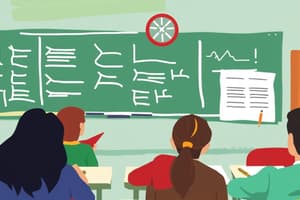Podcast
Questions and Answers
Which of the following is true about testing and assessment?
Which of the following is true about testing and assessment?
- Assessment is only done by teachers.
- Assessment includes both formal and informal methods. (correct)
- Testing is the most effective method of evaluating student progress.
- Testing is the only form of assessment.
What is the purpose of assessment in the classroom?
What is the purpose of assessment in the classroom?
- To evaluate teacher performance
- To inform the teacher about needed instructional interventions (correct)
- To observe student behavior
- To determine student outcomes
What does a teacher do during routine assessment of students?
What does a teacher do during routine assessment of students?
- Corrects student mistakes without analyzing them
- Administers formal tests only
- Observes behavior, gathers information, and makes instructional changes (correct)
- Monitors student progress without evaluating
What does assessment involve in the context of solving math problems?
What does assessment involve in the context of solving math problems?
When does assessment happen in the classroom?
When does assessment happen in the classroom?
Which of the following is true about assessment in the classroom?
Which of the following is true about assessment in the classroom?
What is the purpose of testing in evaluating student progress?
What is the purpose of testing in evaluating student progress?
What does a teacher do after observing a student solving math problems?
What does a teacher do after observing a student solving math problems?
What is one type of assessment described in the text?
What is one type of assessment described in the text?
When does assessment happen in the classroom?
When does assessment happen in the classroom?
According to the three-tier model, which students receive tier-two interventions?
According to the three-tier model, which students receive tier-two interventions?
What are some examples of standardized instruments used for monitoring student progress?
What are some examples of standardized instruments used for monitoring student progress?
What is the purpose of tier-two interventions in the three-tier model?
What is the purpose of tier-two interventions in the three-tier model?
What happens if interventions in the three-tier model do not result in improved student performance?
What happens if interventions in the three-tier model do not result in improved student performance?
What is the purpose of documenting results in the three-tier model?
What is the purpose of documenting results in the three-tier model?
Which type of assessment focuses on a student's potential to learn a new skill rather than testing for mastery of the skill?
Which type of assessment focuses on a student's potential to learn a new skill rather than testing for mastery of the skill?
What is the purpose of error analysis in assessment?
What is the purpose of error analysis in assessment?
What is the purpose of ecological assessment in the evaluation process?
What is the purpose of ecological assessment in the evaluation process?
Which professional organizations have produced the Standards for Educational and Psychological Testing?
Which professional organizations have produced the Standards for Educational and Psychological Testing?
When a student has not had success in a learning environment after several prereferral strategies have been applied, what is the next step that the prereferral intervention team might recommend?
When a student has not had success in a learning environment after several prereferral strategies have been applied, what is the next step that the prereferral intervention team might recommend?
What types of tests are used in a comprehensive evaluation?
What types of tests are used in a comprehensive evaluation?
Flashcards are hidden until you start studying
Study Notes
Assessment in the Classroom
- The primary purpose of assessment is to evaluate student learning and progress.
- Teachers conduct routine assessments to gather data, inform instruction, and identify areas of student strength and weakness.
- Assessment involves observing student problem-solving, monitoring student progress, and documenting results.
Types of Assessments
- Aptitude assessment focuses on a student's potential to learn a new skill rather than testing for mastery of the skill.
- Error analysis is used to identify specific errors or misconceptions in student problem-solving.
- Ecological assessment evaluates the learning environment and its impact on student performance.
Three-Tier Model
- Tier-two interventions are provided to students who require additional support beyond the general education curriculum.
- The purpose of tier-two interventions is to provide targeted support to students who are struggling.
- If interventions do not result in improved student performance, more intensive interventions may be necessary.
Standardized Instruments
- Standardized instruments, such as tests, are used to monitor student progress and evaluate the effectiveness of interventions.
Professional Organizations
- The Standards for Educational and Psychological Testing were produced by professional organizations, including the American Educational Research Association (AERA) and the American Psychological Association (APA).
Prereferral Intervention
- If a student has not had success in a learning environment after several prereferral strategies have been applied, the prereferral intervention team may recommend a comprehensive evaluation.
- A comprehensive evaluation typically involves the use of multiple assessment tools, including tests and other evaluation methods.
Studying That Suits You
Use AI to generate personalized quizzes and flashcards to suit your learning preferences.




